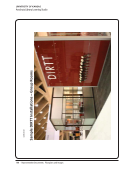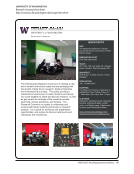SPEC Kit 327: Reconfiguring Service Delivery · 33
6. If a change in service philosophy had a significant impact on the decision to reconfigure this
service, please briefly describe that change and the impact it had. If this did not have a significant
impact, please enter NA for Not Applicable. N=52
13 responded NA.
After the planned renovation, there will be a single service point (there are currently two) and before the change there
were three.
Because of evaluations that had been done, we knew there was an irregular delivery of service within the system.
Changes made standardized and improved service offerings to our users and simplified how/where the users needed to
go for these.
By centralizing service points, we can improve service to users as well as be more efficient with staff time. This change
has certainly changed (lowered) the number of hours individuals spent at a desk, freeing time for other activities.
Comments from users indicate that there is a desire for a more efficient and streamlined experience for checking out
materials and getting reference assistance. In addition, a single service also allows library staff to broaden their skill sets
by becoming cross-trained on both reference and circulation processes.
Cross-training the Government Documents librarians for the Main Reference Desk is the first step toward reducing
service points in the Main Library.
Customer service has always been at the forefront of our decisions to reconfigure our staffing and physical spaces.
So, in this respect, there was no change in service philosophy just the opportunity (funding) to enhance our physical
environment and subsequent staffing models to improve our key services.
Decision to increase the “one-stop shopping” possibilities for our users.
Desired to implement our current service philosophy on the new campus.
I don’t know if it was a significant impact, but the library administration definitely decided that we needed to offer
media services to the campus because it was not being adequately offered elsewhere and our faculty were asking us to
offer it.
In general, the Libraries is moving toward a combined service point approach/philosophy wherever possible, but the
physical layout of the main library building presents obstacles.
In our new organization, we are trying to work across geographical boundaries toward the model of One Library,
One Collection, in order to better support our institution’s interdisciplinary work and current trends in scholarship and
teaching.
In Strategic Initiative 3 &4 (of the strategic plan) there is a call for an appropriate mix of services, expertise
management, and taking advantage of staff expertise. Work on reference questions that had been divided across
departmental lines was expanded out to appropriate staff—simpler questions best answered by circulation or other
staff triaged to their area, more complex &subject-related questions referred to appropriate subject expert—both
in virtual venues and in physical (desk) presence. Bibliographers in Collection Development began to share a larger
role in reference and reference librarians with collections responsibilities having a larger subject-expert role. All taking
responsibility for answering questions appropriately and referring appropriately.
6. If a change in service philosophy had a significant impact on the decision to reconfigure this
service, please briefly describe that change and the impact it had. If this did not have a significant
impact, please enter NA for Not Applicable. N=52
13 responded NA.
After the planned renovation, there will be a single service point (there are currently two) and before the change there
were three.
Because of evaluations that had been done, we knew there was an irregular delivery of service within the system.
Changes made standardized and improved service offerings to our users and simplified how/where the users needed to
go for these.
By centralizing service points, we can improve service to users as well as be more efficient with staff time. This change
has certainly changed (lowered) the number of hours individuals spent at a desk, freeing time for other activities.
Comments from users indicate that there is a desire for a more efficient and streamlined experience for checking out
materials and getting reference assistance. In addition, a single service also allows library staff to broaden their skill sets
by becoming cross-trained on both reference and circulation processes.
Cross-training the Government Documents librarians for the Main Reference Desk is the first step toward reducing
service points in the Main Library.
Customer service has always been at the forefront of our decisions to reconfigure our staffing and physical spaces.
So, in this respect, there was no change in service philosophy just the opportunity (funding) to enhance our physical
environment and subsequent staffing models to improve our key services.
Decision to increase the “one-stop shopping” possibilities for our users.
Desired to implement our current service philosophy on the new campus.
I don’t know if it was a significant impact, but the library administration definitely decided that we needed to offer
media services to the campus because it was not being adequately offered elsewhere and our faculty were asking us to
offer it.
In general, the Libraries is moving toward a combined service point approach/philosophy wherever possible, but the
physical layout of the main library building presents obstacles.
In our new organization, we are trying to work across geographical boundaries toward the model of One Library,
One Collection, in order to better support our institution’s interdisciplinary work and current trends in scholarship and
teaching.
In Strategic Initiative 3 &4 (of the strategic plan) there is a call for an appropriate mix of services, expertise
management, and taking advantage of staff expertise. Work on reference questions that had been divided across
departmental lines was expanded out to appropriate staff—simpler questions best answered by circulation or other
staff triaged to their area, more complex &subject-related questions referred to appropriate subject expert—both
in virtual venues and in physical (desk) presence. Bibliographers in Collection Development began to share a larger
role in reference and reference librarians with collections responsibilities having a larger subject-expert role. All taking
responsibility for answering questions appropriately and referring appropriately.






















































































































































































































